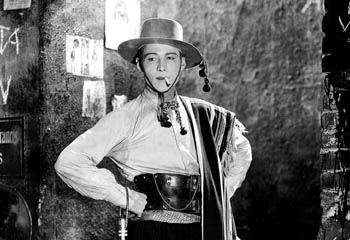![[Metroactive Movies]](/movies/gifs/movies468.gif)
[ Movies Index | Show Times | Silicon Valley | Metroactive Home | Archives ]

It Takes One to Tango: Rudolph Valentino introduced a new dance craze in 1921's 'The Four Horsemen of the Apocalypse.' Silent Running The San Francisco Silent Film Festival re-creates a bygone era in movie magic GENERALLY SPEAKING, movie journalists turn out to be as reliable as swap-meet Rolexes. So let's congratulate one very early cinema journalist for prescience. The writer's name is Blythe Sherwood. He or she is writing about a young actor who, at the time of the article, hadn't had a leading role in any movies and was still making $350 a week salary in 1921 dollars: "He has the indolence of Endymion, who would dream; the reverence of Dante, who would worship; the vitality of Don Juan, who would woo; the extravagance of Don Quixote, who would exaggerate; and the philosophy of Omar [Khayyam], whose 'yesterday is dead and tomorrow never comes.'" The subject of this rhinestone-studded profile was indeed about to make a splash. He was the yet-unknown Rudolph Valentino, about to open in his star-making role in The Four Horseman of the Apocalypse (1921). Valentino was to play a dissolute gaucho who goes to pieces in the night town of Buenos Aires, before finding redemption in the battlefields of Flanders. This post-World War I hit played both sides. It claimed that the Great War had unleashed the riders of the Book of Revelation, but it also supposed that the trenches were a perfect place for a slouch to give his soul a much-needed bath. More important than anything, though, was the star, debuting an exotic and scandalous dance called the tango. During his short and white-hot career, Valentino opposed the lacquered, WASPy leading men of the time. He was, of course, the first great androgynous love god of the cinema. Valentino is one of the attractions at the Ninth Annual Silent Film Festival at the Castro Theatre in San Francisco (July 10-11); the grand old relic of a theater is the perfect place to relearn the power and the magic of silent film. The spice of Valentino's Four Horseman (Saturday, 8pm) is countered with the sugar of The Blue Bird (Saturday, 11am), Maurice Tourneur's silent version of the fairy tale about two poor children in search of the bluebird of happiness. The Dragon Painter (1919; Saturday, 3:45pm) features Sessue Hayakawa in a fulsome symbolist romance about an artist in pursuit of his muse. In Japan, silent films were interpreted by "benshi" performers who commented upon the action: the Hayakawa film includes a performance by local master artist Midori Sawato, demonstrating the technique. Shennu (1934; Sunday, 11:30am) features an early cinematic icon of China, Ruan Lingyu, the Gong Li of her day, acting out a drama of maternal self-annihilation. Such tragedy begs for comedy relief. What Happened to Jones (Saturday, 1:30pm)—introduced by Cyndi Mortensen of the Stanford Theater—is a 1926 comedy about a bachelor party gone awry. Charlie Chaplin's The Circus (1928; Sunday, 8pm) features an in-person visit by Sydney Chaplin, who was born during the making of his father's movie. This world-class film festival celebrates the dream of a universal cinema in which language and nationality were immaterial. In those days, a thickly accented Italian like Valentino could be a mysterious creature on screen, whose voice was all the more intimate for existing only in the imagination.
The San Francisco Silent Film Festival plays July 10-11 at the Castro Theatre, 429 Castro St., San Francisco. Shows are $13/$15. See www.silentfilm.org for schedule details.
Send a letter to the editor about this story to letters@metronews.com. [ Silicon Valley | Metroactive Home | Archives ]
|
Web extra to the July 7-13, 2004 issue of Metro, Silicon Valley's Weekly Newspaper.
Copyright © Metro Publishing Inc. Metroactive is affiliated with the Boulevards Network.
For more information about the San Jose/Silicon Valley area, visit sanjose.com.